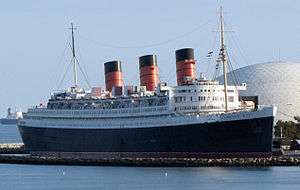
Halogen
The halogens or halogen elements (/ˈhælədʒən, ˈheɪ-, -loʊ-, -ˌdʒɛn/) are a group in the periodic table consisting of five chemically related elements: fluorine (F), chlorine (Cl), bromine (Br), iodine (I), and astatine (At). The artificially created element 117 (ununseptium) may also be a halogen. In the modern IUPAC nomenclature, this group is known as group 17.
The name 'halogen' means 'salt-producing'. When halogens react with metals they produce a wide range of salts, including calcium fluoride, sodium chloride (common salt), silver bromide and potassium iodide.
The group of halogens is the only periodic table group that contains elements in three of the four main states of matter at standard temperature and pressure. All of the halogens form acids when bonded to hydrogen. Most halogens are typically produced from minerals or salts. The middle halogens, that is chlorine, bromine and iodine, are often used as disinfectants. Organobromides are the most important class of flame retardants. Elemental halogens are lethally to dangerously toxic.
Halogen (band)
Halogen is a five-piece band from Perth, Western Australia. Formed in 1998 by two expatriate New Zealanders - Jasmine Yee and Frans Bisschops.
History
The band first gained national prominence in Australia through the song "Hole Around My Heart" from their Somewhere You're Alone recording. The song won the WAM Song of the Year in 2001. With the release of the single "Walkaway", and an accompanying tour of Australia's east coast (including a showcase performance at the Australian Music Week), the band furthered their claim for national attention. The single received rotational airplay on national broadcaster Triple J and a follow-up single, in the form of "On A Bridge", followed suit. Both singles found their way onto the band's debut album Save the Ones You Love. A third single from the album, "Caught Me", was subsequently released and also found rotational airplay.
Rather than take a traditional recording approach for their follow-up album Building On The Edge Of The Sky, songwriters Jasmine Yee and Frans Bisschops directed each composition to a different emerging producer. The result was a brilliant, if somewhat eclectic, recording taking Halogen away from the brooding guitars that previously typified their sound and into the realm of electronica.
Halogen (disambiguation)
The halogens are a series of chemical elements.
Halogen may also refer to:

Poseidon
Poseidon (/pəˈsaɪdən, pɒ-, poʊ-/;Greek: Ποσειδῶν, pronounced [pose͜edɔ́͜ɔn]) was one of the twelve Olympian deities of the pantheon in Greek mythology. His main domain was the ocean, and he is called the "God of the Sea". Additionally, he is referred to as "Earth-Shaker" due to his role in causing earthquakes, and has been called the "tamer of horses". He is usually depicted as an older male with curly hair and beard.
The name of the sea-god Nethuns in Etruscan was adopted in Latin for Neptune in Roman mythology; both were sea gods analogous to Poseidon. Linear B tablets show that Poseidon was venerated at Pylos and Thebes in pre-Olympian Bronze Age Greece as a chief deity, but he was integrated into the Olympian gods as the brother of Zeus and Hades. According to some folklore, he was saved by his mother Rhea, who concealed him among a flock of lambs and pretended to have given birth to a colt, which was devoured by Cronos.
There is a Homeric hymn to Poseidon, who was the protector of many Hellenic cities, although he lost the contest for Athens to Athena. According to the references from Plato in his dialogues Timaeus and Critias, the island of Atlantis was the chosen domain of Poseidon.
Poseidon (short story)
"Poseidon" is a small piece of prose of Franz Kafka, written in 1920.
The sea god Poseidon is presented here as a disgruntled manager of the waters, which he does not really know.
History
In the fall of 1920, Kafka broke away from his lover Milena Jesenska. It was created by a productive push a series of short prose pieces, including "The Refusal". Kafka did not publish them, therefore his friend Max Brod titled them when he published them.
Plot
Poseidon is sitting at the desk and makes calculations on the waters he has to manage. For his work, he could rely on staff, but rather prefers to work on his own. He does not like his work but sees no alternative.
Poseidon laments that people imagine him constantly chauffeuring the waters with his trident. Instead, he sits in the depths of the oceans, doing continuous calculations and hardly ever seeing the sea. Only on his occasional trips to Jupiter, from which he often returns angrily, he sees the sea during a hasty ascent to the Olympus. He is afraid that he will have to wait until the end of the world for a quiet moment and a tour of the sea.

Poseidon (fictional ship)
The S.S. Poseidon is a fictional trans-Atlantic liner that first appeared in the 1969 novel The Poseidon Adventure by Paul Gallico and later in four films based on the novel. The ship is named after the god of the seas in Greek mythology.
Descriptions
The original novel
In the 1969 novel, the steamdriven ship is traveling across the Atlantic on a month-long tour of African and South American ports, after its conversion from an ocean liner into a cruise ship. On December 26, the ship capsizes when a landslide on the Mid-Atlantic Ridge produces a huge tsunami. The description of the ship is slim, but in his novel, Gallico described it as a quadruple-screw ocean liner of 81,000 tons, as long as four city blocks, and as high as an apartment building. He also wrote that it had three "massive" funnels. But he also described it as having a fatal flaw: it "was riding high in the water, improperly ballasted and technically unseaworthy." This, he wrote, made it vulnerable to capsizing by tsunamis.
Podcasts:

